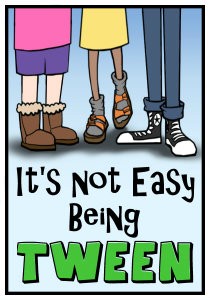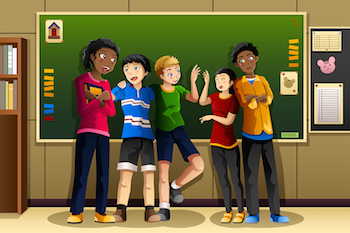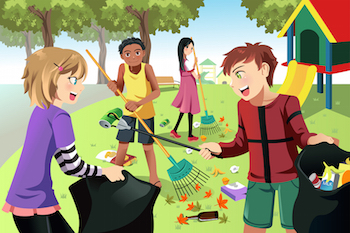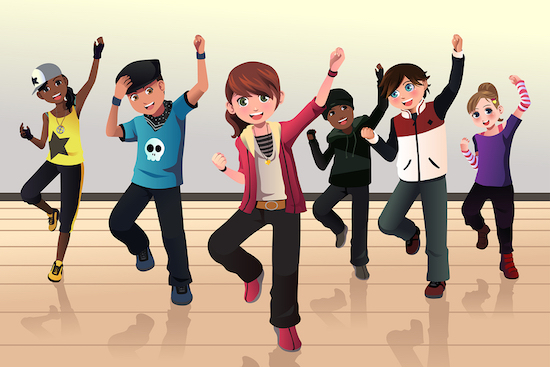Get Kids on the Move in Middle Grades Classes
A MiddleWeb Blog
 My school is lucky to have an extremely dedicated, energetic, positive force in the form of our physical education teacher, Ann. Our students have PE class every other day all year. When they return from her class, they are happier and ready to focus.
My school is lucky to have an extremely dedicated, energetic, positive force in the form of our physical education teacher, Ann. Our students have PE class every other day all year. When they return from her class, they are happier and ready to focus.
All of the research I’ve read shows numerous positive effects on the brain from physical activity. Movement helps channel excess energy, supports memory and mood, improves behavior, and increases retention of material.
Therefore, I decided that my professional goal for the school year is to integrate more purposeful movement into my English classroom.
Before I began brainstorming how to add more physical movement, I determined a set of parameters for the activities I would use.
They had to:
- Be purposeful and integrated with the curriculum (I see this as more valuable than random brain breaks)
- Require little to no cost to implement
- Be easy to explain to the students as well as to facilitate
- Be completed quickly and/or within my 45-minute class period
- Allow all students to feel safe and included
Once I had these criteria in mind, I made a list of all of things I already do and added others I want to try. I loosely sorted them into four categories. These are activities done as individuals, in groups, as a whole class, and using the whole room.
Activities done as individuals
- Card Sorts. Anything that can be categorized works well for this activity. For example, when we study sensory language, the students sort descriptive words into 5 groups—one for each sense. I also use this when we study ethos, pathos, and logos. Words associated with each of these are sorted into the three groups. I’ve also cut apart poems or essays and had students arrange in a logical sequence. (This can also be done in groups.) The possibilities are endless.
- Handing in Papers. Unless it is an assessment, my students get out of their seats and hand in all of their papers in one central location. Even these 10 to 15 steps can help a child refocus.
- Stand Up/Sit Down. This can be done for any activity where there are choices between two responses such as true/false, yes/no, common/proper nouns, agree/disagree. For example, I use a wonderful cross-curricular website called https://quipoquiz.com. On this site, they have dozens of true/false quizzes ranging from 10 to 50 questions. I project a question on the whiteboard and students stand if they believe it to be true and sit if they believe it to be false.
NOTE: Be careful of when you use these activities. I would not want a child to be embarrassed if they were the only one sitting or standing. This should be material that is well-known or opinion based to lessen this chance. The Quipo quizzes are for fun as the questions are unknown to all of the students. I don’t use it as a review.
- Individual Whiteboards. There are infinite uses for these, and my students get really excited to write on them. Any time I want a quick formative assessment, I put these on their tables and we get to work.
- Sticky Notes. Students write their answers on a sticky note, get up and post them on chart paper as directed.
Activities done in groups
- Learning Stations. A recent Middleweb article by Dr. Katherine McKnight reminded me of how much I love using centers in the classroom. I am going to revisit her book for inspiration.
- Become a Human Model. In English class, having students make a tableau of a critical scene is a class favorite. At an especially fun AMLE session a few years ago, Marcia Tate walked us all through learning about positive and negative numbers doing a number line hustle.
- Record a video. Summarizing is a critical concept in language arts. One of ways students can do this is to work together to summarize the crucial learning of the day and film it. They can then post these to a class site for future reference.
Perform a skit. Students always ask if they can do skits. One way this works well in my class is having students develop a Reader’s Theater play of a work. This is especially valuable when we study effective use of dialogue.
- STEM challenges. These are not just for science and math classes. Students can practice effective communication skills in a fun manner.
- Human Board Games. Students become live chess, checker, tic-tac-toe, or connect four games while answering review questions. (This can also be done as a whole class.)
- Escape Rooms. I have done BreakoutEDU games both using the purchased kits and the digital version. An active twist on these is to have the clues be in various locations as they are in actual escape room games. (See this recent MiddleWeb article for more ideas.)
- Jigsaw. This is an oldie but a goodie, but it remains a wonderful way to promote movement and cover a large amount of material in a short amount of time. It also reinforces the skills of summarizing and paraphrasing.
- Dice. Throwing dice and then answering a corresponding question is a quick, low-prep way of discussing a large amount of material.
- Buzzers. I bought an inexpensive set of buzzers for my classroom (one buzzer for each group). Students can buzz in with their group’s answer.
Activities done as a whole class
- Dance. When we read historical fiction, I like to show my students a video of a dance from the time period, and we can even try to learn it. One way to practice following directions is to learn a new dance. A really fun one my students like is the Sid Shuffle starring Sid from the Ice Age movies.
- Hand Signals. I am not a fan of these for classroom management, but I think they can work well to learn vocabulary. For example, when I teach ethos, pathos, and logos, I add a corresponding hand signal to each. For ethos, we raise our right hands as if to take an oath. For pathos, we place our right hand over our hearts. For logos, we touch a finger to our head. This dramatically improves retention and understanding.
Go outside. Weather permitting, my sixth-grade team takes our students outside for recess during the last 10 minutes of lunch (we have no official recess time in our schedule). It makes a huge difference in the after-lunch doldrums. Even though we don’t have perfect weather year-round in Michigan, I am going to make an effort to take students outside for class or a quick activity or task when possible.
- Charades. We play charades with the literal meanings of idioms, but it is also fun to see them use their creativity to come up with a way to act out academic vocabulary.
- Throw an object. Soft objects such as a stuffed animal or a koosh ball work well for this. The student who catches the ball answers the question you asked verbally. I also have several variations on this using a beach ball with questions written on it. When studying prepositions, students make and throw paper airplanes and then write or say three sentences describing the movement of the airplane using prepositions.
- Concentric Circles. Students stand in concentric circles facing one another. After they finish completing the discussion or answering the question, they rotate to a new partner.
Activities using the whole room
- Gallery Walks. These are another classic strategy, for good reason. Gallery Walks are a great way to share and validate student work.
- Continuums or Four Corners. When something involves an opinion, students choose their answer based on a room-length continuum you’ve established. A variation is four corners allowing only four options for response.
- Think-Mix-Pair. Divide the number of students in the class in half. Determine a question for that number and write each one on an index card. Write the answer on a different card. Distribute one card to each child. Students think about what they believe will be the answer to their question and vice versa. They walk around the room looking for their partner.
Share your ideas!
I know there are hundreds of other ideas out there, and I look forward to continuing to add to my list. Please share!







































Keep them moving mentally and with a variety of tools. Try the free PicLits on an interactive whiteboard. Here’s how one class in Texas used it to write visual poetry.
I will share your list next month with teachers, children and parents that I work with in Nepal and Malaysia, where students often sit at their desks, most of the day. I will also share the online quiz game: https://quipoquiz.com, as suggested in #3. One of the strengths of your list is that it reads like the brainstorm that it is, encouraging others to create their own brainstorm, and add to the list. The importance of movement for kids of all ages is as basic as being human. Increased movement increases brain power, social interaction, a sense of confidence, etc. To quote the Movement as Medicine website: “Movement is fundamental to what it is to be human, to be alive, to be adaptable to change… and life is change.” Thanks, Cheryl, for this playfully serious set of activities.
Good article, The importance of movement for kids of all ages is as basic as being human. Increased movement increases brain power, social interaction, a sense of confidence,thank you for sharing.
I had 10 extra minutes in one of my Spanish classes today. I pulled up a vocabulary set on Quizlet I had created that corresponded to this week’s lesson. Since I have an interactive whiteboard, I let students come up (one at a time) to play the timed matching game. For those not familiar with the game, the words and their definitions (or the words and their translations in my class) appear randomly on the board. When a student uses their finger to drop a word onto a definition, the matched pair disappears. The timer stops when all pairs have disappeared. The students loved trying to get the lowest time! And when each attempt only takes 15-30 seconds, a lot of students get a chance in a short amount of time.